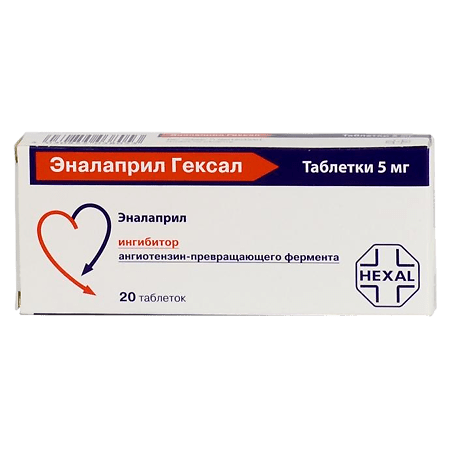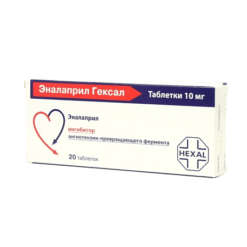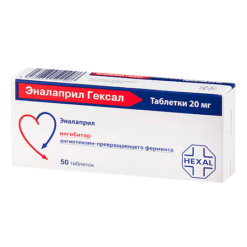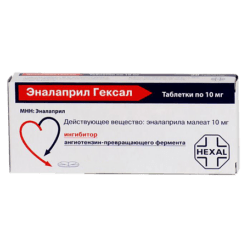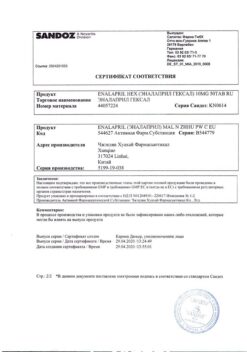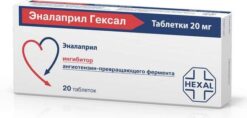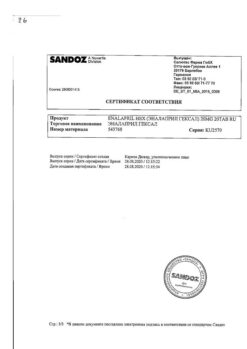No products in the cart.
Enalapril Hexal, tablets 5 mg 20 pcs
€2.54 €2.12
Description
Enalapril is an ACE inhibitor. It is a prodrug from which the active metabolite enalaprilate is formed in the body. It is believed that the mechanism of antihypertensive action is connected with competitive inhibition of ACE activity, which leads to decrease of conversion rate of angiotensin I into angiotensin II (which has strong vasoconstrictor effect and stimulates secretion of aldosterone in adrenal cortex).
The decrease in angiotensin II concentration results in a secondary increase in plasma renin activity by eliminating the negative feedback of renin release and a direct decrease in aldosterone secretion. In addition, enalaprilat appears to influence the kinin-callicrein system by inhibiting the breakdown of bradykinin.
Because of its vasodilator effect, it decreases RPO (postload), congestion pressure in the pulmonary capillaries (preload) and pulmonary vascular resistance; it increases cardiac minute volume and exercise tolerance.
In patients with chronic heart failure, long-term use of enalapril increases exercise tolerance and reduces the severity of heart failure (as assessed by NYHA criteria). Enalapril in patients with mild to moderate heart failure slows its progression and also slows the development of left ventricular dilatation. In left ventricular dysfunction, enalapril reduces the risk of major coronary outcomes (including the rate of myocardial infarction and the number of hospitalizations for unstable angina).
Pharmacokinetics
In oral administration about 60% is absorbed from the gastrointestinal tract. Simultaneous intake of food has no effect on absorption. It is metabolized in the liver by hydrolysis to form enalaprilat, due to the pharmacological activity of which the hypotensive effect is realized. Binding of enalaprilat with plasma proteins is 50-60%.
The T1/2 of enalaprilat is 11 hours and increases with renal insufficiency. After oral administration, 60% of the dose is excreted by the kidneys (20% as enalapril, 40% as enalaprilat), 33% is excreted through the intestine (6% as enalapril, 27% as enalaprilat). After intravenous administration of enalaprilat, 100% is excreted unchanged by the kidneys.
Indications
Indications
Active ingredient
Active ingredient
Composition
Composition
1 tablet contains:
the active ingredient:
enalapril 5 mg;
excipients:
sodium bicarbonate,
lactose monohydrate,
corn starch,
talc,
hyprolose,
magnesium stearate
How to take, the dosage
How to take, the dosage
Daily doses are usually taken in the morning, however, the drug can be divided into 2 times – morning and evening.
Simultaneous use of diuretics may increase the hypotensive effect.
Arterial hypertension:
The initial dose is 5 mg in the morning. If at this dose the blood pressure value does not normalize, the daily dose may be increased to 10 mg. The interval between increases should be at least 3 weeks.
The maintenance dose is usually 10 mg of enalapril maleate.
The maximum daily dose should not exceed 40 mg daily.
Chronic heart failure:
The initial dose is 2.5 mg in the morning. The dose should be increased gradually, depending on the condition of the patient.
The maintenance dose is usually 5 – 10 mg. The maximum daily dose should not exceed 20 mg.
Left ventricular dysfunction:
The initial dose is 2.5 mg of enalapril maleate 2 times a day, the dose can be adjusted depending on the patient’s condition. The average maintenance dose is 10 mg 2 times a day.
Patients with moderate renal impairment (creatinine clearance 30 – 60 ml/minute) and patients aged over 65 years:
The initial dose is 2.5 mg in the morning.
The maintenance dose is usually 5 – 10 mg of enalapril maleate per day. The maximum daily dose should not exceed 20 mg of enalapril.
Patients with severe renal impairment (creatinine clearance less than 30 ml/min) and those on hemodialysis:
The starting dose is 2.5 mg of enalapril maleate per day.
Patients on hemodialysis should take the drug after dialysis.
The maintenance dose is usually 5 mg enalapril per day. The maximum daily dose should not exceed 10 mg per day.
The drug may be used as monotherapy or in combination with other antihypertensive agents, especially diuretics.
Interaction
Interaction
Concomitant use with immunosuppressants, cytostatics increases the risk of leukopenia.
Concomitant use of potassium-saving diuretics (including spironolactone, triamterene, amiloride) may lead to hyperemia. spironolactone, triamterene, amiloride), potassium preparations, salt substitutes and dietary supplements containing potassium may develop hyperkalemia (especially in patients with kidney dysfunction) because ACE inhibitors decrease aldosterone, which leads to potassium retention in the body with limited potassium excretion or its additional intake.
The simultaneous use of opioid analgesics and anesthetics increases the antihypertensive effect of enalapril.
The simultaneous use of “loop” diuretics, thiazide diuretics increases the antihypertensive effect. There is a risk of hypokalemia. Risk of renal dysfunction increase.
In concomitant use with azathioprine development of anemia is possible due to inhibition of erythropoietin activity under the influence of ACE inhibitors and azathioprine.
A case of anaphylactic reaction and myocardial infarction has been described when using allopurinol in a patient receiving enalapril.
Acetylsalicylic acid in high doses may decrease the antihypertensive effect of enalapril.
Whether acetylsalicylic acid reduces the therapeutic efficacy of ACE inhibitors in patients with CHF and heart failure has not been definitively established. The nature of this interaction depends on the course of the disease.
Acetylsalicylic acid, by inhibiting COX and prostaglandin synthesis, may cause vasoconstriction, which leads to decreased cardiac output and worsening of heart failure patients receiving ACE inhibitors.
Simultaneous use of beta-adrenoblockers, methyldopa, nitrates, calcium channel blockers, hydralazine, prazosin may increase the antihypertensive effect.
In concomitant use with NSAIDs (including indomethacin) antihypertensive effect of enalapril decreases, probably due to inhibition of prostaglandin synthesis (which is believed to play a role in development of hypotensive effect of ACE inhibitors) under the influence of NSAIDs. Risk of renal function abnormalities increases; hyperkalemia is rarely observed.
With simultaneous use of insulin, hypoglycemic agents of sulfonylurea derivatives hypoglycemia may develop.
With simultaneous use of ACE inhibitors and interleukin-3 there is a risk of arterial hypotension.
With concomitant use with clozapine there are reports of syncope.
With concomitant use with clomipramine there are reports of increased effect of clomipramine and development of toxic effects.
With co-trimoxazole there are described cases of hyperkalemia.
Concomitant use with lithium carbonate increases serum lithium concentration, which is accompanied by symptoms of lithium intoxication.
Concomitant use with orlistat decreases antihypertensive effect of enalapril, which may cause significant increase in BP, development of hypertensive crisis.
It is believed that concomitant use with procainamide may increase the risk of leukopenia.
Concomitant use with enalapril reduces the effect of drugs containing theophylline.
There have been reports of acute renal failure in patients after renal transplantation when concomitant use with cyclosporine.
Concomitant use with cimetidine increases T1/2 of enalapril and increases its concentration in blood plasma.
It is believed that simultaneous use with erythropoietins may decrease the effectiveness of antihypertensive agents.
Simultaneous use with ethanol increases the risk of arterial hypotension.
Special Instructions
Special Instructions
Particular caution is used in patients with autoimmune diseases, diabetes mellitus, hepatic dysfunction, severe aortic stenosis, subaortic muscle stenosis of unclear genesis, hypertrophic cardiomyopathy, loss of fluid and salts. In case of previous saluretic treatment, particularly in patients with chronic heart failure, the risk of orthostatic hypotension increases, therefore the loss of fluids and salts should be compensated before starting enalapril treatment.
In long-term treatment with enalapril, peripheral blood counts should be monitored periodically. Sudden discontinuation of enalapril does not cause a sudden increase in BP.
In surgical interventions during enalapril treatment, arterial hypotension may occur, which should be corrected by administration of adequate fluid.
Enalapril should be stopped before parathyroid function study.
Impact on driving and operating machinery
Caution is required when driving vehicles or performing other work requiring increased attention because dizziness may occur, especially after taking the initial dose of enalapril.
Contraindications
Contraindications
Side effects
Side effects
CNS and peripheral nervous system disorders: dizziness, headache, fatigue, increased fatigue; very rarely with high doses – sleep disorders, nervousness, depression, balance disorders, paresthesias, tinnitus.
Cardiovascular system disorders: orthostatic hypotension, fainting, palpitations, heart pain; very rare with high doses – hot flashes.
The digestive system: nausea; rarely – dry mouth, abdominal pain, vomiting, diarrhea, constipation, liver disorders, increased liver transaminases activity, increased blood bilirubin concentration, hepatitis, pancreatitis; very rare in high doses – glossitis.
The hematopoietic system: rarely – neutropenia; in patients with autoimmune diseases – agranulocytosis.
Urinary system disorders: rare – renal dysfunction, proteinuria.
Respiratory system disorders: dry cough.
Reproductive system disorders: very rare when used in high doses – impotence.
Dermatological reactions: very rare in high doses – hair loss.
Allergic reactions: rarely – skin rash, Quincke’s edema.
Others: rarely – hyperkalemia, muscle cramps.
Overdose
Overdose
Symptoms: marked decrease of blood pressure, up to the development of collapse, myocardial infarction, acute cerebral circulation disorder or thromboembolic complications, convulsions, stupor.
Treatment: the patient is transferred to a horizontal position with a low headboard. In mild cases gastric lavage and oral intake of saline solution are indicated, in more severe cases – measures aimed at BP stabilization: intravenous infusion of saline solution, plasma substitutes, angiotensin II administration, hemodialysis if necessary (elimination rate of enalaprilat averages 62 ml/minute).
Pregnancy use
Pregnancy use
It is contraindicated in pregnancy.
Enalapril should be stopped immediately if pregnancy occurs.
Enalapril is excreted with breast milk.
If its use is necessary during lactation, discontinuation of breastfeeding should be considered.
Similarities
Similarities
Additional information
| Shelf life | 3 years. |
|---|---|
| Conditions of storage | Keep out of reach of children at a temperature not exceeding 25 °C! |
| Manufacturer | Salutas Pharma GmbH, Germany |
| Medication form | pills |
| Brand | Salutas Pharma GmbH |
Other forms…
Related products
Buy Enalapril Hexal, tablets 5 mg 20 pcs with delivery to USA, UK, Europe and over 120 other countries.

